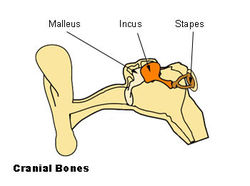- Ossicles
-
Not to be confused with Ossicone.
Ossicles 
Ossicles 
Chain of ossicles and their ligaments, seen from the front in a vertical, transverse section of the tympanum. Latin ossicula auditus; ossicula auditoria Gray's subject #231 1044 MeSH Ear+Ossicles Dorlands/Elsevier Ossicles The ossicles (also called auditory ossicles) are the three smallest bones in the human body. They are contained within the middle ear space and serve to transmit sounds from the air to the fluid-filled labyrinth (cochlea). The absence of the auditory ossicles would constitute a moderate-to-severe hearing loss. The term "ossicles" literally means "tiny bones" and commonly refers to the auditory ossicles, though the term may refer to any small bone throughout the body.
Contents
Etymology
Ossicle dates to c. 1570, from Latin Ossiculum, a diminutive of Latin Os "bone" (Genitive: Ossis).[1] The malleus gets its name from Latin malleus, meaning "hammer",[2] the Incus gets its name from Latin Incus meaning "anvil" from incudere meaning "to forge with a hammer",[3] and the Stapes gets its name from Modern Latin "stirrup," probably an alteration of Late Latin Stapia related to stare "to stand" and pedem, a accusative of pes "foot", so called because the bone is shaped like a stirrup - this was an invented Modern Latin word for "stirrup," for which there was no classical Latin word, as the ancients did not use stirrups.[4]
Anatomy
The ossicles are, in order from the eardrum to the inner ear (biologically/medically from superficial to deep), the malleus, incus, and stapes. Terms that, in Latin, are translated as the hammer, the anvil, and the stirrup.
- The malleus (hammer) articulates with the incus and is attached to the tympanic membrane (eardrum), from which vibrational sound pressure motion is passed.
- The incus (anvil) is connected to both the other bones.
- The stapes (stirrup) articulates with the incus and is attached to the membrane of the fenestra ovalis, the elliptical or oval window or opening between the middle ear and the vestibule of the inner ear.
Function
As sound waves vibrate the tympanic membrane (eardrum), it in turn moves the nearest ossicle, the malleus, to which it is attached. The malleus then transmits the vibrations, via the incus, to the stapes, and so ultimately to the membrane of the fenestra ovalis, the opening to the vestibule of the inner ear.
The ossicles give the eardrum mechanical advantage via lever action and a reduction in the area of force distribution; the resulting vibrations would be much smaller if the sound waves were transmitted directly from the outer ear to the oval window. However, the extent of the movements of the ossicles is controlled (and constricted) by certain muscles attached to them (the tensor tympani and the stapedius). It is believed that these muscles can contract to dampen the vibration of the ossicles, in order to protect the inner ear from excessively loud noise (theory 1) and that they give better frequency resolution at higher frequencies by reducing the transmission of low frequencies (theory 2) (see acoustic reflex). These muscles are more highly developed in bats and serve to block outgoing cries of the bats during echolocation (SONAR).
Occasionally the joints between the ossicles become rigid. One condition, otosclerosis, results in the fusing of the stapes to the oval window. This reduces hearing and may be treated surgically.
The quality of sound is improved by impedance matching.
Development
Studies have shown that ear bones in mammal embryos are attached to the dentary, which is part of the jaw. These are ossified portions of cartilage -- called Meckel's cartilage -- that are attached to the jaw. As the embryo develops, the cartilage hardens to form bone. Later in development, the bone structure breaks loose from the jaw and migrates to the inner ear area. The structure is known as the middle ear, and is made up of the incus, stapes, malleus, and tympanic membrane. These correspond to the quadrate, prearticular, articular, and angular structures in the reptile jaw. For this reason, researchers believe the similarity of the results shows that mammals and reptiles have a common ancestry.[5]
References
- ^ http://www.etymonline.com/index.php?term=ossicle
- ^ http://www.etymonline.com/index.php?term=malleus
- ^ http://www.etymonline.com/index.php?term=incus
- ^ http://www.etymonline.com/index.php?term=stapes
- ^ Meng, Jin. "The Journey From Jaw to Ear." Biologist. vol. 50. (2003) p. 154-158.
External links
Bones (TA A02, GA 2) Axial Thoracic skeletonsternum · ribFacial bonesnasal · maxilla · lacrimal · zygomatic · palatine · inferior nasal conchae · vomer · mandible · THROAT: hyoid (greater cornu, lesser cornu, body)OssiclesAppendicular LowerCategories:- Auditory system
- Bones of the head and neck
Wikimedia Foundation. 2010.
